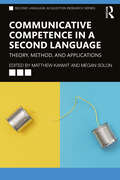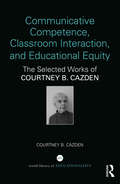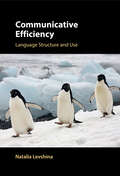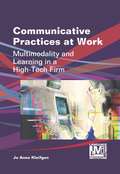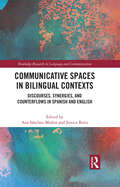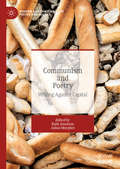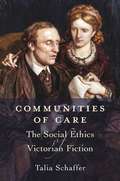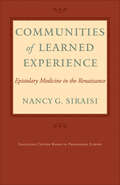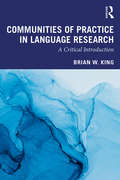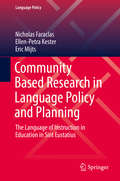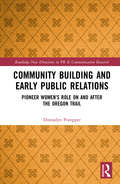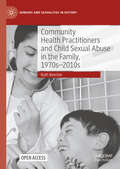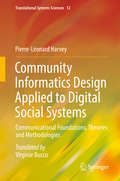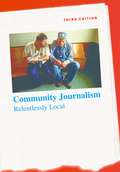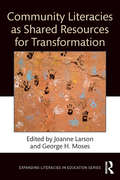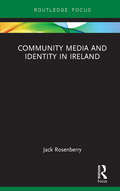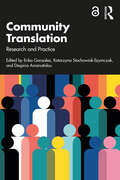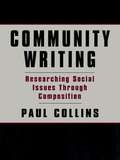- Table View
- List View
Communicative Competence in a Second Language: Theory, Method, and Applications (Second Language Acquisition Research Series)
by Megan Solon Matthew KanwitCommunicative competence is an essential language skill, the ability to adjust language use according to specific contexts and to employ knowledge and strategies for successful communication. This unique text offers a multidisciplinary, critical, state-of-the-art research overview for this skill in second language learners. Expert contributors from around the world lay out the history of the field, then explore a variety of theoretical perspectives, methodologies, and empirical findings, and authoritatively set the agenda for future work. With a variety of helpful features like discussion questions, recommended further reading, and suggestions for practice, this book will be an invaluable resource to students and researchers of applied linguistics, education, psychology, and beyond.
Communicative Competence, Classroom Interaction, and Educational Equity: The Selected Works of Courtney B. Cazden
by Courtney B. CazdenIn the World Library of Educationalists series, international scholars themselves compile career-long collections of what they judge to be their finest pieces—extracts from books, key articles, salient research findings, major theoretical and/or practical contributions—so the world can read them in a single manageable volume. Readers thus are able to follow the themes and strands of their work and see their contribution to the development of a field, as well as the development of the field itself. Contributors to the series include: Michael Apple, James A. Banks, Joel Spring, William F. Pinar, Stephen J. Ball, Elliot Eisner, Howard Gardner, John Gilbert, Ivor F. Goodson, and Peter Jarvis. In this volume, Courtney B. Cazden, renowned educational sociolinguist, brings together a selection of her seminal work, organized around three themes: development of individual communicative competence in both oral and written language and discourse; classroom interaction in learning and teaching; and social justice/educational equity issues in wider contexts beyond the classroom. Since the 1970s, Cazden has been a key figure in the ethnography of schooling, focusing on children’s linguistic development (both oral and written) and the functions of language in formal education, primarily but not exclusively in the United States. Combining her experiences as a former primary schoolteacher with the insight and methodological rigor of a trained ethnographer and linguist, Cazden helped to establish ethnography and discourse analysis as central methodologies for analyzing classroom interaction. This capstone volume highlights her major contributions to the field.
Communicative Efficiency: Language Structure and Use
by Natalia LevshinaAll living beings try to save effort, and humans are no exception. This groundbreaking book shows how we save time and energy during communication by unconsciously making efficient choices in grammar, lexicon and phonology. It presents a new theory of 'communicative efficiency', the idea that language is designed to be as efficient as possible, as a system of communication. The new framework accounts for the diverse manifestations of communicative efficiency across a typologically broad range of languages, using various corpus-based and statistical approaches to explain speakers' bias towards efficiency. The author's unique interdisciplinary expertise allows her to provide rich evidence from a broad range of language sciences. She integrates diverse insights from over a hundred years of research into this comprehensible new theory, which she presents step-by-step in clear and accessible language. It is essential reading for language scientists, cognitive scientists and anyone interested in language use and communication.
Communicative English 11th Standard - Tamilnadu Board
by Training State Council of Educational ResearchCommunicative English Textbook for the 11th Standard Students, preparing for Tamil Nadu State Board Exam.
Communicative English 12th Standard - Tamilnadu Board
by Training State Council of Educational ResearchCommunicative English Textbook for the 12th Standard Students, preparing for Tamil Nadu State Board Exam.
Communicative English class 11 (Higher Secondary First Year) - Tamil Nadu Board
by State Council of Educational Research and TrainingThe "Communicative English" textbook for Class 11 by the Tamil Nadu Board aims to develop proficiency in English through practical usage. It begins with national symbols and pledges, such as the National Anthem, Tamil Thaai Vaazhthu, and the National Integration Pledge, fostering patriotism and unity. The preface highlights the need for mastering listening, speaking, reading, and writing skills to gain confidence in using the language accurately. The book is thematic, revolving around real-life contexts to help students link their experiences with various situations, thereby enhancing communicative skills. It includes a variety of tasks designed to encourage practice in all four language skills, with grammar introduced through real-life contexts to improve fluency and accuracy. Additionally, it incorporates ICT codes and a career guidance section, providing students with opportunities to explore new learning avenues and career options in fields such as travel, tourism, logistics, and hotel management. The book aims to not only develop language skills but also instill humane values, promoting kindness, loyalty, and appreciation for nature.
Communicative English class 12 (Higher Secondary Second Year) - Tamil Nadu Board
by Tamil Nadu BoardThe "Communicative English" textbook for Class XII, published by the Government of Tamil Nadu under the Free Textbook Programme, aims to develop students' communicative competence rather than just linguistic skills. Emphasizing real-life applications, the textbook includes authentic materials such as extracts from media, magazines, and books, tailored to the learners' needs and interests. It focuses on practical communication skills, such as public speaking, interviewing, and debating, rather than traditional essay writing. The book incorporates study skills like note-taking and reference, and it encourages digital literacy through an ICT corner. It promotes values like equality and harmony, aiming for proficiency in language use in new contexts. The textbook also includes themes on human values, workplace English, road safety, art and literature, and civic sense, providing a comprehensive language learning experience aligned with the National Curriculum Framework 2005.
Communicative Perspectives on COVID-19 in Ghana: At the Intersection of Culture, Science, Religion and Politics (Routledge Studies in Language and Intercultural Communication)
by Mark Nartey Nancy Henaku G. Edzordzi AgbozoThis collection explores the communicative dimensions of the COVID-19 pandemic in Ghana, redressing the absence of perspectives from Africa and the Global South in pandemic discourses and highlighting the importance of considering the impact of local contexts in global crises. The volume critically reflects on the significance of communicative dimensions, understood here as the effects of communication on bidirectional flows between senders and receivers, on many different aspects of the coronavirus pandemic. Grounded in transnational and interdisciplinary perspectives and drawing on data from the Ghanian experience, the book showcases how important it is for local factors to be taken into account by governments, medical professionals, social commentators, and everyday people in communicating during a pandemic, when local cultures, histories, and infrastructures all play a role in shaping communication and the dissemination of knowledge. Chapter examines such topics as the role of metaphor, the use of social media in disinformation, and the range of strategies and channels employed by stakeholders. This volume centers the pandemic experience in a Global South context, demonstrating the importance of a greater focus on local contexts in understanding communication in a time of pandemic. This book will be of interest to students and scholars in intercultural communication, crisis communication, health communication, discourse analysis, and African studies.
Communicative Practices at Work
by Jo Anne KleifgenThis book examines communicative practices in a circuit-board manufacturing plant in California's Silicon Valley, where the employees come from diverse ethnolinguistic backgrounds, their activities involve the use of high-tech equipment and their practices are shaped by, and sometimes contest, local and global forces. Analyses of the data show that learning occurs optimally when workers make strategic use of both their home languages and English within an ecology of semiotic systems. The book demonstrates the importance of accounting for multilingual practices in studies of multimodality. Through detailed ethnography it brings the reader to a better understanding of learning-in-practice in work environments, where the complexities and accelerated growth of new technologies along with a globalized world produce new forms of multilingual and multimodal communication.
Communicative Spaces in Bilingual Contexts: Discourses, Synergies and Counterflows in Spanish and English (Routledge Research in Language and Communication)
by Jessica Retis Ana Sánchez-MuñozThis collection bridges disciplinary scholarship from critical language studies, Latinx critical communication, and media studies scholarship for a comprehensive exploration of Spanish-English bilingualism in the US and in turn, elucidating, more broadly, our understanding of bilingualism in a post-digital society. Chapters offer a state-of-the-art on research at the intersection of language, communication, and media, with a focus on key debates in Spanish-English bilingualism research. The volume provides a truly interdisciplinary perspective, synthesizing a wide range of approaches to promote greater dialogue between these fields and examining different communicative bilingual spaces. These include ideological spaces, political spaces, publicity and advertising spaces, digital and social media spaces, entertainment and TV spaces, and school and family spaces. This book will be of interest to students and scholars in bilingualism, language and communication, language and media, and Latin American and Chicano/a studies.
Communion of Radicals: The Literary Christian Left in Twentieth-Century America
by Jonathan McGregorPopular perceptions of American writers as either godless radicals or God-fearing reactionaries overlook a vital tradition of Christian leftist thought and creative work. In Communion of Radicals, Jonathan McGregor offers the first literary history of theologically conservative writers who embraced political radicalism, as their reverence for tradition impelled them to work for social justice. Challenging recent accounts that examine twentieth-century American literature against the backdrop of the rising Religious Right, Communion of Radicals uncovers a different literary lineage in which allegiance to religious tradition fostered dedication to a more just future.From the Gilded Age to the Great Depression to the civil rights movement, traditional faith empowered the rebellious writing of socialists, anarchists, and Catholic personalists such as Vida Scudder, Dorothy Day, Claude McKay, F. O. Matthiessen, and W. H. Auden. By recovering their strain of traditioned radicalism, McGregor shows how strong faith in the past can fuel the struggle for an equitable future. As Christian socialists, Scudder and Ralph Adams Cram envisioned their movement for beloved community as a modern version of medieval monasticism. Day and the Catholic Workers followed the fourteenth-century example of St. Francis when they lived and wrote among the disaffected souls on the Bowery during the Great Depression. Tennessee’s Fellowship of Southern Churchmen argued for a socialist and antiracist understanding of the notion of “the South and the Agrarian tradition” popularized by James McBride Dabbs, Walker Percy, and Wendell Berry. Agrarian roots flowered into creative expressions encompassing the queer and Black medievalist poetry of Auden and McKay, respectively; Matthiessen’s Catholic socialist interpretation of the American Renaissance; and the genteel anarchism of Percy’s southern comic novels. Imaginative writing enabled these Christian leftists to commune with the past and with each other, driving their radical efforts in the present.Communion of Radicals chronicles a literary Christian left that unites deeply traditional faith with radicalism, and offers a usable past that disrupts perceived alignments of religion and politics.
Communism and Poetry: Writing Against Capital (Modern and Contemporary Poetry and Poetics)
by Julian Murphet Ruth JennisonCommunism and Poetry: Writing Against Capital addresses the relationship between an upsurge in collective political practice around the world since 2000, and the crystallization of newly engaged forms of poetry. Considering an array of perspectives—poets, poet-critics, activists and theorists—these essays shed new light on the active interface between emancipatory political thought and poetic production and explore how poetry and the new communism are creating mutually innovative forms of thought and activity, supercharging the utopian imagination. Drawing inspiration from past connections between communism and poetry, and theorizing new directions over the years ahead, the volume models a much-needed critical solidarity with creative strategies in the present conjuncture to activate movements of resistance, on the streets and in verse.
Communities in Fiction (Commonalities)
by J. Hillis MillerCommunities in Fiction reads six novels or stories (one each by Trollope, Hardy, Conrad, Woolf, Pynchon, and Cervantes) in the light of theories of community worked out (contradictorily) by Raymond Williams, Martin Heidegger, and Jean- Luc Nancy.The book’s topic is the question of how communities or noncommunities are represented in fictional works. Such fictional communities help the reader understand real communities, including those in which the reader lives. As against the presumption that the trajectory in literature from Victorian to modern to postmodern is the story of a gradual loss of belief in the possibility of community, this book demonstrates that communities have always been presented in fiction as precarious and fractured. Moreover, the juxtaposition of Pynchon and Cervantes in the last chapter demonstrates that period characterizations are never to be trusted. All the features both thematic and formal that recent critics and theorists such as Fredric Jameson and many others have found to characterize postmodern fiction are already present in Cervantes’s wonderful early-seventeenth-century “Exemplary Story,” “The Dogs’ Colloquy.” All the themes and narrative devices of Western fiction from the beginning of the print era to the present were there at the beginning, in CervantesMost of all, however, Communities in Fiction looks in detail at its six fictions, striving to see just what they say, what stories they tell, and what narratological and rhetorical devices they use to say what they do say and to tell the stories they do tell. The book attempts to communicate to its readers the joy of reading these works and to argue for the exemplary insight they provide into what Heidegger called Mitsein— being together in communities that are always problematic and unstable.
Communities of Care: The Social Ethics of Victorian Fiction
by Talia SchafferWhat we can learn about caregiving and community from the Victorian novelIn Communities of Care, Talia Schaffer explores Victorian fictional representations of care communities, small voluntary groups that coalesce around someone in need. Drawing lessons from Victorian sociality, Schaffer proposes a theory of communal care and a mode of critical reading centered on an ethics of care.In the Victorian era, medical science offered little hope for cure of illness or disability, and chronic invalidism and lengthy convalescences were common. Small communities might gather around afflicted individuals to minister to their needs and palliate their suffering. Communities of Care examines these groups in the novels of Jane Austen, Charlotte Brontë, Charles Dickens, George Eliot, Henry James, and Charlotte Yonge, and studies the relationships that they exemplify. How do carers become part of the community? How do they negotiate status? How do caring emotions develop? And what does it mean to think of care as an activity rather than a feeling? Contrasting the Victorian emphasis on community and social structure with modern individualism and interiority, Schaffer’s sympathetic readings draw us closer to the worldview from which these novels emerged. Schaffer also considers the ways in which these models of carework could inform and improve practice in criticism, in teaching, and in our daily lives.Through the lens of care, Schaffer discovers a vital form of communal relationship in the Victorian novel. Communities of Care also demonstrates that literary criticism done well is the best care that scholars can give to texts.
Communities of Learned Experience: Epistolary Medicine in the Renaissance (Singleton Center Books in Premodern Europe)
by Nancy G. SiraisiSixteenth-century physicians had their letters on medical topics published in printed collections to record their exchange of ideas and make known their professional expertise.During the Renaissance, collections of letters both satisfied humanist enthusiasm for ancient literary forms and provided the flexibility of a format appropriate to many types of inquiry. The printed collections of medical letters by Giovanni Manardo of Ferrara and other physicians in early sixteenth-century Europe may thus be regarded as products of medical humanism. The letters of mid- and late sixteenth-century Italian and German physicians examined in Communities of Learned Experience by Nancy G. Siraisi also illustrate practices associated with the concepts of the Republic of Letters: open and relatively informal communication among a learned community and a liberal exchange of information and ideas. Additionally, such published medical correspondence may often have served to provide mutual reinforcement of professional reputation. Siraisi uses some of these collections to compare approaches to sharing medical knowledge across broad regions of Europe and within a city, with the goal of illuminating geographic differences as well as diversity within social, urban, courtly, and academic environments. The collections she has selected include essays on general medical topics addressed to colleagues or disciples, some advice for individual patients (usually written at the request of the patient’s doctor), and a strong dose of controversy.
Communities of Practice in Language Research: A Critical Introduction
by Brian W. KingCommunities of Practice in Language Research provides an up-to-date and critical introduction to the community of practice framework and how this can be applied to language research. Critiquing and offering alternative suggestions for the ways in which researchers frame research participants as members of communities of practice, with the goal of inspiring use of the Community of Practice (CofP) model in new areas of research, this book: engages in extended critical analysis of past research as well as questioning recent applications and suggesting limitations incorporates instructive examples from multiple fields, including Sociolinguistics, Linguistic Anthropology, Critical Discourse Studies, Language Teaching & Learning, Literacy Studies, and a trailblazing section on Language & Digital Media brings up-to-date the key questions and concerns around the Communities of Practice model, debunking myths and re-emphasising ongoing challenges. Communities of Practice in Language Research is essential reading for undergraduate and postgraduate students studying research methods or undertaking research projects in those areas.
Community Based Research in Language Policy and Planning: The Language of Instruction in Education in Sint Eustatius (Language Policy #20)
by Nicholas Faraclas Ellen-Petra Kester Eric MijtsThis volume focuses on a case where community organizing, academic research and governmental responsibility were successfully mobilized and synchronized to bring about change in educational policy and practice. The focus of this book is the methodology implemented and the results obtained over the course of a year-long action research project on language and education in St. Eustatius, one of the islands of the Dutch Caribbean, commissioned by the educational authorities in both St. Eustatius and the European Netherlands. On the island, the language of instruction is Dutch, however, outside of the classroom most students only speak English and an English-lexifier Creole. The research project was set up to address the negative impact on school success of this disparity. It included a community-based sociolinguistic study that actively involved all of the stakeholders in the education system on the island. This was complemented by a multi-pronged set of research strategies, including a language attitude and use survey, a narrative proficiency test, in depth interviews, and a review of the relevant literature. The resulting report and recommendations were accepted by the government, which is now in the process of changing the language of instruction.
Community Building and Early Public Relations: Pioneer Women’s Role on and after the Oregon Trail (Routledge New Directions in PR & Communication Research)
by Donnalyn PompperFrom the start, women were central to a century of westward migration in the U.S. Community Building and Early Public Relations: Pioneer Women’s Role on and after the Oregon Trail offers a path forward in broadening PR's Caucasian/White male-gendered history in the U.S. Undergirded by humanist, communitarian, critical race theory, social constructionist perspectives, and a feminist communicology lens, this book analyzes U.S. pioneer women's lived experiences, drawing parallels with PR's most basic functions – relationship-building, networking, community building, boundary spanning, and advocacy. Using narrative analysis of diaries and reminiscences of women who travelled 2,000+ miles on the Oregon Trail in the mid-to-late 1800s, Pompper uncovers how these women filled roles of Caretaker/Advocate, Community Builder of Meeting Houses and Schools, served a Civilizing Function, offered Agency and Leadership, and provided Emotional Connection for Social Cohesion. Revealed also is an inevitable paradox as Caucasian/White pioneer women’s interactional qualities made them complicit as colonizers, forever altering indigenous peoples’ way of life. This book will be of interest to undergraduate and graduate PR students, PR practitioners, and researchers of PR history and social identity intersectionalities. It encourages us to expand the definition of PR to include community building, and to revise linear timeline and evolutionary models to accommodate voices of women and people of color prior to the twentieth century.
Community Health Practitioners and Child Sexual Abuse in the Family, 1970s-2010s (Genders and Sexualities in History)
by Ruth BeecherThis open access book is an innovative history of community health practitioners’ responses to the seemingly intractable problem of men (and on rare occasions, women) sexually abusing children within the private family home. It is situated within a social history of the development of British community-based health professions in the last decades of the twentieth century. Drawing on archival research and newly gathered in-depth oral history interviews, the monograph argues that expectations placed upon community-based doctors, nurses and mental health staff since the 1980s in relation to predicting and preventing the sexual abuse of children by men they know are incongruous. Beneath a surface acquiescence to the need to protect children from such abuse or to intervene early lie cultural, social and structural barriers that prevent its fulfilment. The book is a first in specifically interrogating the recent history of the role of community health practitioners within the modern 'child protection workforce', and contributes to growing scholarship on the history of emotions in the medical professions.
Community Informatics Design Applied to Digital Social Systems
by Pierre-Léonard Harvey Virginie BuccoThis book introduces a Digital Social System Praxis Framework (DSSPF) integrating Computational Media, Evolutionary Systems Thinking and Design Thinking approaches to E-transformation practice, also called Community Informatics Design (CID). The DSSPF framework is intended to create communication spaces dedicated to knowledge production and sharing for social and organizational change. It allows social systems researchers and practitioners to recognize their synergistic roles in the praxis process to shape their future through social innovation projects. This transdisciplinary text provides potential students and practitioners fundamental concepts and tools for such design. It offers resources from the Pragmatic and Systemic philosophy of science for the co-construction of social architectures and infrastructures, and multi-aspectual design methodologies by which government, organizations and civil society can learn to ethically co-design common ground. This approach provides complementary and common patterns from known methods, models, and theories of social systems interventions that could support a generic framing of large scale sociotechnical systems: digital social innovation ecosystem, living Labs, Fab Labs, enterprise collaborative networks.There will be a particular focus on understanding and addressing the dimensions that make people from different communities of practice able to communicate and collaborate through multiple digital media, design platforms, worldviews and modeling approaches.
Community Journalism
by Jock LautererNo matter how ambitious they may be, most novice journalists don't get their start at the New York Times. They get their first jobs at smaller local community newspapers that require a different style of reporting than the detached, impersonal approach expected of major international publications. As the primary textbook and sourcebook for the teaching and practice of local journalism and newspaper publishing in the United States, Community Journalism addresses the issues a small-town newspaper writer or publisher is likely to face.Jock Lauterer covers topics ranging from why community journalism is important and distinctive; to hints for reporting and writing with a "community spin"; to design, production, photojournalism, and staff management. This third edition introduces new chapters on adjusting to changing demographics in the community and "best practices" for community papers. Updated with fresh examples throughout and considering the newest technologies in editing and photography, this edition of Community Journalism provides the very latest of what every person working at a small newspaper needs to know.
Community Literacies as Shared Resources for Transformation (Expanding Literacies in Education)
by Joanne Larson George H. MosesThrough multiple narratives reflecting the complexity of participatory action research partnerships for social justice, this book sheds light on the dialogic spaces that intentionally support community literacies and rhetorical practices for inquiry and change. Applying literacy as social practice, Larson and Moses tell a story of a unique collaboration between community members and university faculty and students, who together transformed an urban corner store into a cornerstone of the community. Building on the emerging field of community literacies, the book captures the group’s active work on the ground and, on another level, how transformation occurred in the dialogic spaces of the research team as it learned to embrace distributed expertise and multiple identities.
Community Media and Identity in Ireland (Routledge Focus on Media and Cultural Studies)
by Jack RosenberryThis book explores how Ireland’s community media outlets reflect and shape identity at the local level. While aspects of its culture date back centuries, the nation-state of Ireland is less than one hundred years old. Because of this and other elements of the island’s history, Irish identity is a contested topic and the island is a place where culture, identity and geography are tightly intertwined. By addressing how community media serve as agents for community building, the book examines how they in turn influence the way individuals connect with their communities.
Community Translation: Research and Practice
by Katarzyna Stachowiak-Szymczak Despina Amanatidou Erika GonzálezCommunity translation or public service translation is on a global scale often unregulated and dependent on individual awareness, good will and even charity work. The social impact and mission of community translation, the key role of the translator’s psycho-sociocultural awareness and its role depending on local and global changes in human migration and linguistic diversity make community translation a constantly evolving and yet under-investigated activity and profession. This book covers key practical and theoretical approaches towards community translation, providing insights into the current state of the field and the latest research, trends, guidelines, initiatives and gaps. Combining knowledge in the areas of translator ethics, pedagogy, legal, and social and health-related settings, this volume covers community translation in a wide range of countries and regions. Community Translation: Research and Practice is an essential guide both for those studying and working in this area worldwide. This volume is a springboard for further studies and research in this emerging field. Chapter 4 of this book is freely available as a downloadable Open Access PDF at http://www.taylorfrancis.com under a Creative Commons Attribution-Non Commercial-No Derivatives (CC-BY-NC-ND) 4.0 license.
Community Writing: Researching Social Issues Through Composition
by Paul S. CollinsCommunity Writing: Researching Social Issues Through Composition employs a series of assignments that guide students to research and write about issues confronting their individual communities. Students start by identifying a community to which they belong and focusing on problems in it, and then analyze possible solutions, construct arguments for them, decide which are likely to succeed, and consider how to initiate action. This is a primary text for first-year composition courses, covering the basics of the writing process. The assignments are recursive. Short writing assignments in each chapter build up to longer papers. Each of the assignment questions is accompanied by a guide to thinking about and writing the assigned paper, followed by a short Focus On reading that provides a brief account of community activism, a media case study, or a notable success story. The longer papers are accompanied by in-class peer reading groups. Each successive peer reading attempts a higher level of conceptual critique. By working together throughout the semester, students create increasingly adept peer groups familiar with all stages of each other's research. The book is carefully structured, but there is plenty of "give" in it, allowing instructors to be flexible in adapting it to the needs of their students and courses. Community Writing: * is distinguished by pedagogy based on a collaborative, process-oriented, service learning approach that emphasizes media critique and field research on community issues chosen by individual students; * answers real student questions, such as: Where do I find articles on my topic? What if evidence contradicts my hypothesis? How do I know if a source is biased?; * is web-savvy--guides students into building their own Web sites, including a unique guide for critiquing the design and veracity of other people's websites; and * is media-savvy--topics include media monopolies, spin control, dumbing down, misleading statistics, the Freedom of Information Act, "crackpot" authors, political rhetoric, and fallacious argumentation.
